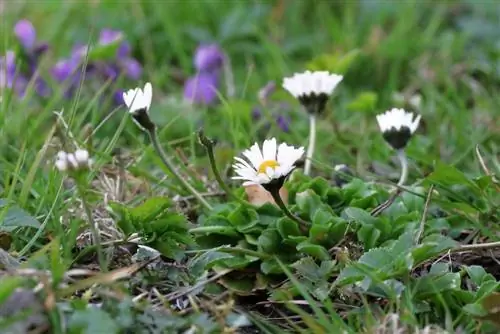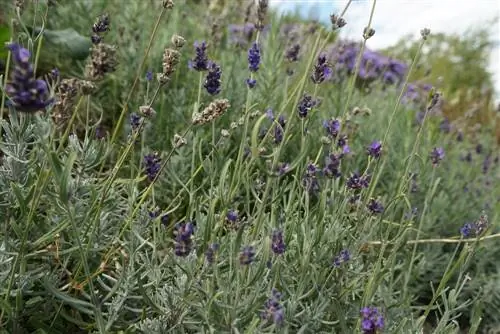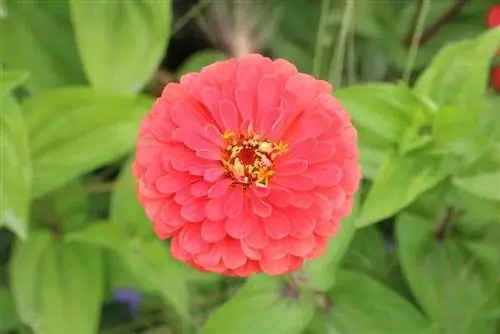- Author admin [email protected].
- Public 2023-12-17 03:39.
- Last modified 2025-06-01 06:48.
Lycopersicon esculentum, as the tomato is called in botanical terminology, came to Europe as a cultivated form. The Aztecs and Incas have been growing the vegetable as a food and medicinal plant for more than two thousand years. Since the 18th century, we have developed numerous non-seed varieties whose taste characteristics make them stand out from the mass of modern industrial varieties.
Large variety of tomatoes
The legendary “Holland tomato” - industrially grown in huge greenhouses, usually red and round and almost tasteless - can hardly be found in supermarkets anymore. Modern varieties are increasingly being bred for taste, but they still have serious disadvantages: the lack of diversity is one of them. The historical world of tomatoes has countless shapes, colors and flavors to offer. Whether salad tomatoes, plum tomatoes, beef tomatoes, cocktail tomatoes, sauce tomatoes (like the famous 'San Marzano' tomato) or dried tomatoes: the fruits can be not only round, red or yellow. There are also striped, green-brown, purple, orange or pink varieties, as well as egg, heart or bottle-shaped, ribbed or flattened varieties. They taste juicy, floury, fruity, sweet or sour, like potatoes, are soft or firm, sometimes weigh five, sometimes 500 grams.
Old tomato varieties have proven themselves for centuries
Probably the oldest German tomato variety is called 'Lukullus'. The tried-and-tested, early-ripening variety was a widespread commercial variety at the beginning of the 20th century, but today - like so many historic tomato varieties - it is no longer commercially approved for economic reasons. However, your seeds can still be purchased from specialist retailers, and new plants can always be grown from self-gathered seeds. 'Lukullus' has round, red fruits that begin to ripen around 150 to 190 days after sowing. Although they are not as firm as today's varieties, they are very tasty and can be grown wonderfully in the home garden. They are suitable for both outdoor cultivation and under glass cultivation. When it comes to yellow tomatoes, the legendary 'Golden Queen' is probably one of the oldest varieties.
Advantages of historic tomatoes over modern varieties
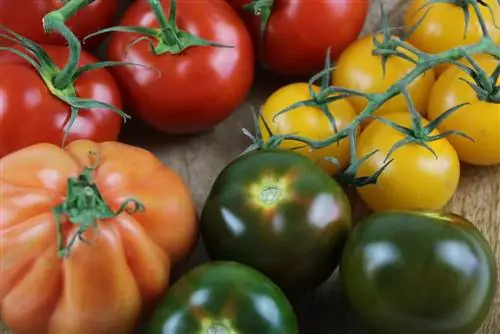
In English, the historic or old tomato varieties are also referred to as “heirloom tomatoes”, which in German means something like “heirloom tomatoes”. These varieties were sometimes passed down from one generation to the next over centuries. They are always true to seeds - a distinguishing feature and a significant advantage of old varieties over modern F1 hybrids - and have been selected for appearance, taste, susceptibility to disease and suitability for cultivation. Today, these often local treasures are both a cultural asset from days gone by and living genetic material for future plant breeding: a valuable treasure that we must preserve.
Benefits of old tomatoes at a glance:
- seed festival
- Seeds can be collected and propagated yourself
- great variety in shape, color, size and taste
- often very robust against various diseases
- tried and proven over centuries
- valuable genetic material
Tip:
Many breeders have already tried to create a variety that is resistant to the dreaded late blight. Nobody has succeeded yet. Many of the old varieties last for a certain period of time, but can still become diseased in wet summers. There is currently only one effective remedy against this tomato disease: protect the heat-loving plants from rain and excessive moisture.
Local Breeds
The tomato came to Europe from South America in the 16th century and was initially only cultivated as an ornamental plant for many centuries. It was only from around the 18th and 19th centuries that vegetables were increasingly bred and grown for consumption. First, countless local varieties emerged, some of which were only bred in one area or even by one family. One example is the large-fruited, yellow-orange 'Schellenberg's Favorit', which comes from a family of the same name near Mannheim and is said to have come to the USA with American soldiers in the post-war years. For this reason, many of the old varieties are not suitable for cultivation in different climate zones, as they have been specifically selected for the local climatic and geographical conditions and have adapted perfectly to them.
Heirloom tomato varieties for every location
It's good that there are so many different varieties. This means you can find the right tomato for every location. In areas that are not so warm and can only be planted later, early-ripening varieties are just right. Their ripening time is shorter, so the fruits can definitely ripen by autumn. Old tomatoes such as 'Lily of the Valley', 'Early Yellow Striped' or 'Homosa' are perfect for rather harsh regions and cool summers. By the way, tomatoes of the same variety taste very different under different growing conditions, which is why you shouldn't just base your selection on the description of the variety - try out different old tomato varieties to see how they react to your local conditions.
Particularly he althy: wild tomatoes
Wild tomatoes are completely unprocessed varieties that have retained their natural character and taste. These varieties are often very he althy, robust and vigorous. The fruits are numerous and ripen quickly, but are very small. A typical representative of the robust wild tomato is the 'currant tomato', which is available with both red and yellow fruits. These only measure about a centimeter in diameter, but are very cute and particularly popular with children. Wild tomatoes grow very lushly, reaching a height of around 150 to 200 centimeters and just as wide. They also form a lot of stingy shoots, which, however, do not need to be removed: pinching out has no influence on the size of the fruit or the harvest.
Other recommended wild tomatoes:
- 'Yellow cocktail tomato': fruity-sweet, pear-shaped fruits, one to three centimeters in diameter
- 'Orange Wild Tomato': fruity-sweet, round fruits, two to three centimeters large, burst resistant
- 'Wild Tomato Pink': very small, fruity-sweet fruits, thin peel
- 'Red Marble': robust, very high-yielding variety with round, red fruits
Particularly tasty heirloom tomato varieties
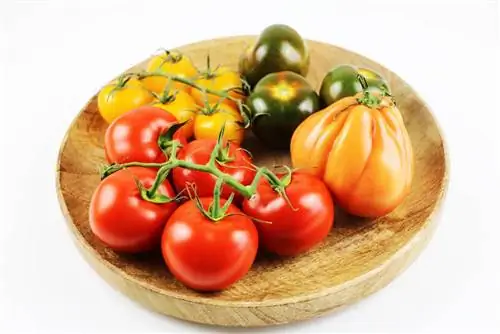
In addition to the wild tomatoes already mentioned - which are not cultivated - the following old tomato varieties are particularly suitable for cultivation in the home garden or greenhouse due to their insensitivity and taste. In addition, the varieties presented here are those that require comparatively little care.
‘Bernese Roses’
It is not known whether this very old Swiss tomato variety actually comes from Bern. The fact is, however, that their highly aromatic fruits develop wonderfully even in cool summers and at higher altitudes. The robust stick tomato, which grows up to around 160 centimeters high, should be grown outdoors if possible and requires a rain cover. The round, somewhat flattened fruits measure between five and ten centimeters in diameter.
Tip:
The 'Bernese roses' are not particularly productive. For this reason, there has been a new breed of the same name for several years that produces significantly more yield. However, their aroma does not come close to that of the original variety. So when buying seeds, pay attention to which of the two varieties you get.
‘Brandywine Pink’
This very old beefsteak tomato comes from the USA. It is characterized by its high yield and the firm, large fruits. These can weigh between 300 and 700 grams and are very juicy and aromatic.
‘De Berao’
This is a very robust variety that is resistant to late blight and brown rot, which is sometimes incorrectly available under the name 'tree tomato'. The stick tomato grows over three meters high and produces numerous oval fruits that can be red, yellow, pink or dark. Harvest time is between mid-July and the end of October.
‘Yellow Pear’
This very vigorous cocktail tomato branches very heavily and develops many stingy shoots. The elongated, yellow fruits are between two and four centimeters tall and ripen in umbel-like fruit clusters, each of which can contain up to 30 fruits. The fruity, sweet-tasting tomatoes ripen from mid-July, but tend to split open a bit. The variety, which probably comes from Russia, can grow very tall - up to 250 centimeters - and therefore always needs a support.
‘Green Zebra’
This tomato variety fascinates with its decorative, green-light green striped fruits, which can also turn yellow-orange depending on the degree of ripeness. The aroma is often described as melon-like and is very intensely fruity. Under favorable conditions, 'Green Zebra' will grow to more than two meters tall and should be grown either in a greenhouse or outdoors with a rain cover. The harvest period is very long from mid-July to the end of October, although unripe fruits can still be harvested in autumn. They mature well indoors.
Tip:
There are various green tomato varieties that produce green or yellow-green fruits even when ripe. Usually green tomatoes are unripe and poisonous because they contain solanine. This also applies to unripe green tomatoes. However, you can recognize ripe and therefore edible fruits by the fact that their peel gives slightly when pressure is applied.
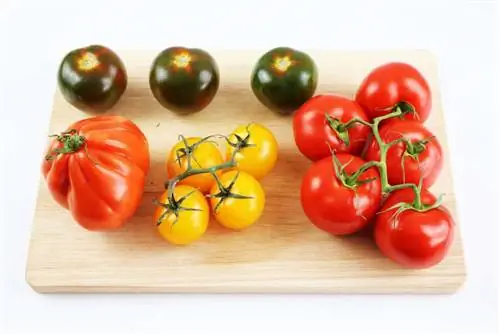
‘Mexican Honey Tomato’
This old variety with its very aromatic fruits should under no circumstances be confused with the commercially available 'honey tomatoes'. The latter are non-seed hybrids. The 'Mexican honey tomato' is very vigorous and productive, but should be cultivated in a greenhouse protected from wind and weather. It makes sense to let this tomato climb up a trellis with multiple shoots. The honey-sweet, up to three centimeters large fruits can be harvested from mid-July.
‘Oxheart’
There are various 'Oxheart' tomatoes, all of which typically produce very large and heavy fruits - typically these are up to 15 centimeters tall and weigh up to a kilogram. Oxheart tomatoes have few seeds and a fairly firm flesh. The fruit-bearing shoots should be supported as much as possible so that they do not break or bend under the load. If you are growing in a greenhouse, you can also fix it over the plants with a pole. All known varieties probably go back to a breed imported to America from Kazakhstan in 1901.
Recommended ‘Ochsenherz’ varieties:
- ‘Cur de buf’
- ‘Cuore di bue’
- ‘Olympic Flame’
- ‘Orange Russian’
- ‘Red Peach’ and ‘White Peach’

These are two very special stick tomatoes whose fruits are covered with a thick, soft, hairy skin. The varieties, which grow up to two meters high, are among the medium-late to late varieties. The first fruits only ripen at the beginning of August. However, the harvest lasts until around mid-October, even when grown outdoors. The tomatoes are very aromatic with a fruity, slightly sweet taste. The thick shell is very soft.
Tip:
There are a few hairy tomato varieties, but they should always be cultivated with rain protection. Experience has shown that they are quite susceptible to brown blight and late blight.
'Russian Travel Tomato'
This very unusual tomato variety was probably already cultivated by the Mayans in Guatemala. However, it is known from Russia, where it is taken as provisions, especially when traveling on the Trans-Siberian Railway. The special thing about this tomato is its curious shape: it looks as if several tomatoes have grown together. The individual pieces of fruit can be broken off from each other. The travel tomato grows up to two meters high and is best grown as a multi-shoot stick tomato.
‘Tigerella’
The origin of this very old stick tomato is not exactly certain, but it probably comes from Russia. 'Tigerella' is very robust and vigorous. The plant, which grows up to two meters high, branches profusely and can easily be grown with multiple shoots. The fruity-sweet tasting fruits are medium-sized, red with yellow stripes and ripen from mid-July. The variety thrives best in a greenhouse, but also grows outdoors, well protected from rain.
‘Whippersnapper’
This variety, which comes from England, is perfect for cultivation in pots, balcony boxes or hanging baskets - the plant only grows to around 40 centimeters high. The fruits are about one to two centimeters large, are red, round to oval and have a fruity-sweet taste. In contrast to many other balcony tomatoes, 'Whippersnapper' (which translates as 'three cheese high') ripens very early and has a long harvest period until the first frost.


